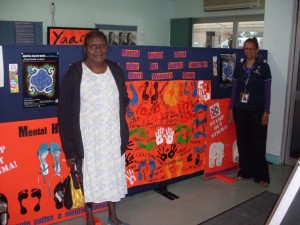
Every once in a while a truly inspiring and touching story comes along. I’d like to share one of these stories with you today. It’s a story about art therapy helping indigenous women in Australia overcome trauma. It brought tears to my eyes once before, and I was ecstatic to follow up and share with you this wonderful story again.
The following is an exclusive look into the wonderful work that Lee George is doing in Australia (want to make a difference? check out some art therapy schools in Australia) to help indigenous women overcome so much trauma. She is proof that one person can make a big difference. I’m honored to share her story and hope it is as inspiring for you as it is me. An image gallery and slide presentation are below as well. Enjoy…
Marapai Ngarthathati Murri Women’s Group
by Lee George
I have been involved with the Marapai Ngarthathati Murri Women’s Group, in Mount Isa, Queensland, Australia since June of this year. The Women’s group came about a number of years ago after an increase in the experience of Aboriginal and Torres Strait Islander women coming before the court system because of offending behavior.
Marapai has two separate groups. One is the group workshop where ladies come every Tuesday night to receive support and strength from the Elders, Aunty Topsy and Aunty Nancy, two well respected Elders in the Mount Isa community. They also attend to receive support and friendship from each other. The group is facilitated by two very lovely ladies in our community, Aunty Dolly Hankin and Aunty Elizabeth Dempsey, who work tirelessly with Elders Aunty Nancy and Aunty Topsy. Also offering their support is many “helping services” in the Mount Isa community, who all attend on a regular basis to offer advice, information and support and encouragement to these women.
Mount Isa is the biggest rural city geographically in Australia. It encompasses Mount Isa, to the south, Djarrah and Boulia, east is Cloncurry and heading towards the north is Doomadgee, Mornington Island, Kuramba and Normanton.
Many of the women who attend the workshops on a Tuesday come from these communities, and have all experienced some form of violence. Some have also spent some time in the prison system for various offences and the majority of them have also had their children removed because of child protection issues created from the violence they have experience.
As a social worker working within the Mental Health field, and also as an contemporary Indigenous artist, I have combined the two professions to create an Art for Healing program that enables Aboriginal and Torres Strait Islander women that I work with to be able to explore their experiences of violence, grief, loss and other traumas through the practice of Art. The reason that I call it Art for Healing rather than Art Therapy is that I use culturally appropriate ways of engaging with clients and the process takes on a non-directive approach which enables the women in the group to be able to freely express their experiences rather than being governed by me.
Initially only one woman attended the Art for Healing workshop, but now there are usually between 10 and 15 women who attend regularly. The women paint, do beadwork, clay work, sketch, make Care Bags out of calico (these bags are made by NWQPHC staff, a primary Indigenous health care organization in Mount Isa) to give to the Department of Child Safety (the idea behind this was for the women to make the bags and fill them with special things from home to give to their children who have been removed because of various child safety issues and concerns) and generally enjoy being in a space in which they are able to just “be”.
To facilitate such a program is a great personal and professional journey for me, because although we are all Indigenous and come from different country and our experiences may appear to be similar, how we cope with those issues is unique to each woman. Some of the participants are drug and alcohol dependant, some live on the riverbed and are homeless, and some attend because they are sanctioned by the courts. The majority of the women who attend have had their children removed from their care. And some attend because they need to be around other women with shared experience. The use of art to encourage these women to engage and help them through their crises through creativity is inspiring and uplifting. It allows them to move to a place than enables high levels of self-esteem and is also about capacity building.
The plan is to have an art exhibition, open day and to eventually publish a book that showcases the women as artists, who have moved from a place of great pain and turmoil to where they are now, peaceful and striving to be women who they can be proud of. At the end of the day what is important is that we are all healing together as women. The workshops have blossomed into a whole of community approach for women’s healing through art practice, food, yarning and most of laughter.
Image Gallery: Art Therapy Helps Indigenous Women Heal From Trauma
About the Art for Healing Program in Australia
Slide Presentation Transcript:
Slide 1:
Art for Healing Program
Marapai Ngartathati Murri Women’s Group
Mornington Island PCYC, Grannies & APH and Mums & Bubs
2009
Slide 2:
Art for Healing Program – Burke Street Diversionary Services, NWQPHC & NWQICSS
The Art for Healing Program
- Indigenous based perspective and practice rather than utilizing a psychological western framework and model
- Assists in the healing processes of Aboriginal and Torres Strait Island women & men who have experienced social issues such as drug and alcohol abuse, domestic violence, removal of children, social and emotional well being issues
- Encourages participants to be interpreters of their own stories and journeys in a creative & culturally appropriate manner
- Empowering community members to actively participate in group work
- Providing counselling in a culturally appropriate setting
- Allows spontaneous creative pursuits
- Enables participants to share their experiences with other Indigenous community members who have been through a similar journey.
- Encouraging community Elders to attend and share their knowledge and experiences
- Community engagement with community stakeholders
- Capacity building through art practice
Slide 3: Burke Street Art Space
Slide 4: Proposed activities for Burke Street Art Space
- Care bags – As a lot of our participants have had their children removed, the idea of Care bags is for mums who attend the Art Space to make the bags out of calico and then paint the bags, and fill them with things that are meaningful and special, such as soft toys, photos, bunny rugs, letters and then present them to Child Safety to give to their children in care
- Women‘s Empowerment Bracelets
- Women’s and Men’s Empowerment T-shirts
- Burke Street Art for Healing Book Project – modeled on the book published by Southside Education in Brisbane. I am currently writing a proposal and submission in conjunction with Burke Street Diversionary Centre to fund this project
- Clay making & Fimo clay making
- Bead making
- Open day in February to show case the stories, images and artist profiles of the participants
Slide 5: PCYC – Mornington Island – Balloon Bombs
Slide 6: Grannies & APH Group – Mornington Island
Slide 7: Indigenous Social Work & Art Practice
As an Indigenous woman, social worker and artist, I feel comfortable sharing my experiences and journeys through my art practice. I have found that the experiences of many of the women that I work with is similar to that of my own. By that I mean that at some stage we as women have all been oppressed either by the men in our lives, our choices and or by a system or institution. If I can facilitate a process where Indigenous women are able to work through their trauma and grief in a culturally appropriate manner through art practice, in a safe and caring environment, it will enable a process that facilitates healing and more importantly empowerment.
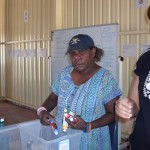
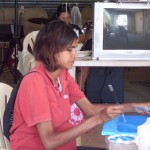
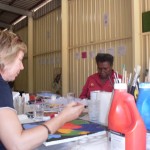
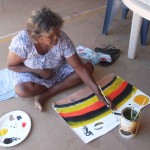
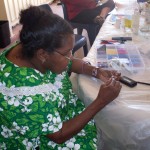
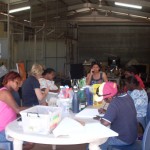

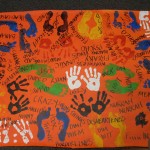
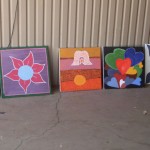
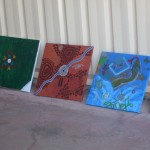
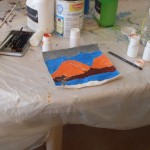
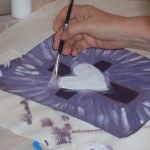
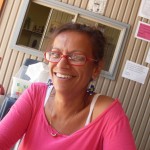
This is fantastic. Congrats to Lee and the amazing work she’s doing!
This looks like a really beautifully combined way of working where the Women are able to lead and work from an Indigenous perspective. As is the way that would work more sucessfully, this makes sense!
Well done and keep up the brilliant work.
I am sure there are lots of Art Therapist’s out there who would like to work with Indigenous people (you can include me in this)so I am hoping this work will expand. It would be great if Lee and other’s working successfully with Indigenous people gave training or presentations perhaps, if this is appropriate in order for others to learn.
Either way, I am glad this is such a successful program.
Inspiring to see wonderful programs like this. Gives me some ideas and hope for our area and the work we are trying to do.
Thanks.
Thank you for this post–this whole blog! I’m experiencing such relief from PTSD since giving myself totally to Art Therapy. It could change the world and I’m so glad you are doing so much to communicate about Art Therapy online. It made it less intimidating to search and find compassionate voices about PTSD.
@Candi, Thank you so much for the kind words. I really appreciate hearing people enjoy the site. Thanks!
It is amazing to me, that the cultural aspect of a group of people being worked with, has taken so long to become deemed important! How long that it has taken to appreciate the healing cultures, of our forefathers. Realize that each individual, is socialized into their cultures, which makes it a part of the individual’s experience, perspective and way to understand everything. Guess that is what happens when humanity, uses denial as a way of life, instead of the survival tool that it is meant to be.
Oh, Yes! Great work being done! I myself am looking for how to create a recovery program with the information and art, that I have put together over the years of my own, recovery from mental confusion. Taken 50 plus years, but it is completed and I now have to find where this tool can be applied to “Help”! All good luck with your program! Is a long, hard path trodden, to do good works. Please, Continue to Continue!
I would like to work with you
Beautiful inspiring work! I would love to impliment something similar in the community I am working in current in the cape and would be interested in touching base with people who have tried similare art groups…